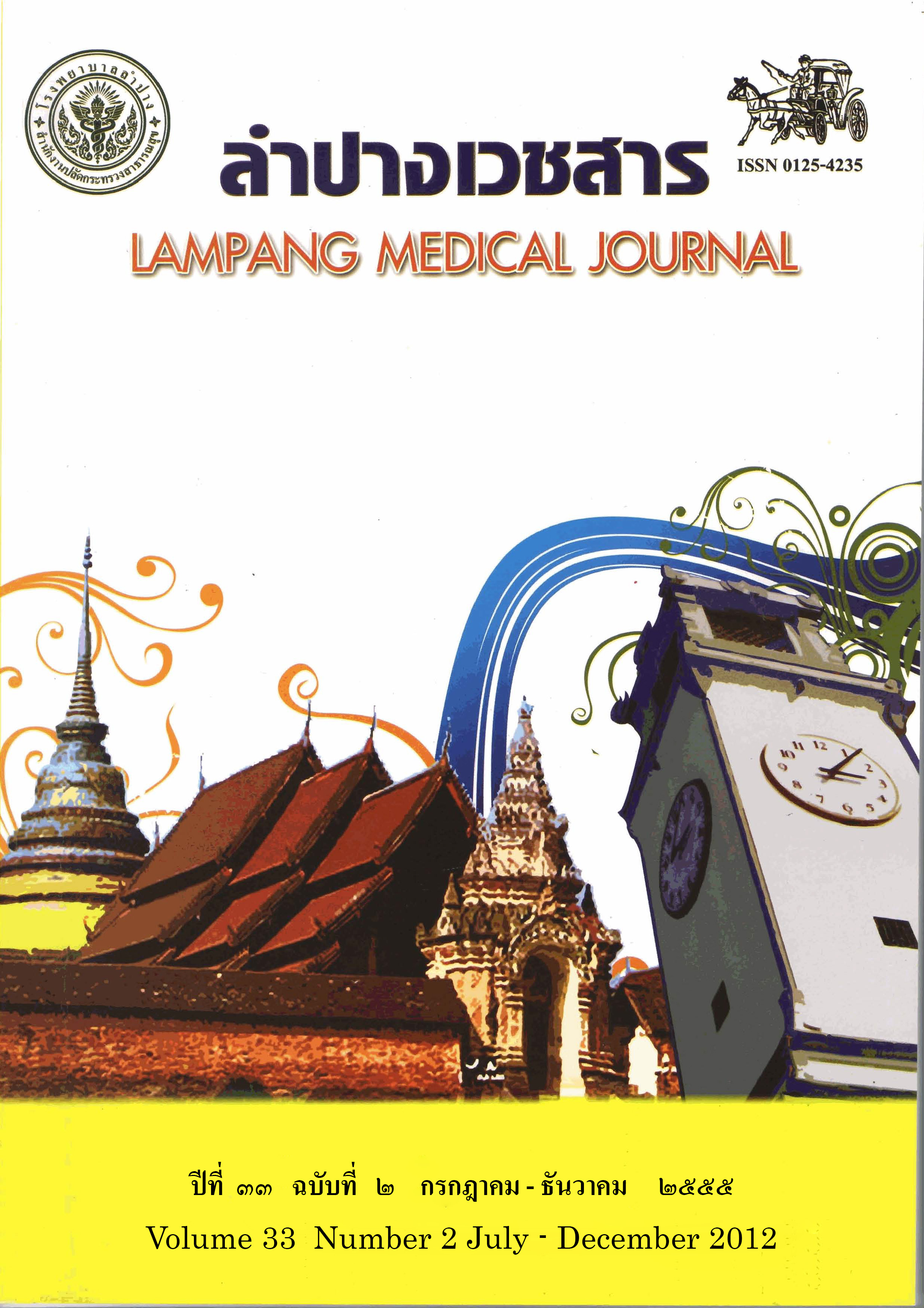Endotracheal Intubation in the Emergency Department of Lampang and Phrae Hospital
Main Article Content
Abstract
Background : Endotracheal intubation is the gold standard for emergency airway management. It composes of 3 techniques; awake, sedate only and rapid sequence intubation (RSI). There is no previous study about intubation in the emergency department of Lampang and Phrae Hospital.
Objective: To study the indications, diagnoses, methods and results of intubation in patients requiring emergency airway management.
Material and method: In this prospective observational study, data obtained from 253 patients requiring endotracheal intubation in emergency department of Lampang and Phrae Hospital during March to June 2012 included patient’s demographics, indications, diagnoses, intubation techniques, duration, success rate and complications. Comparison among 3 intubation techniques was statistically analyzed.
Results: The mean age was 60.1 ± 19.5 years (range, 0.4-100). 57.3% were male and 152 cases intubated in Lampang Hospital. All of them underwent orotracheal intubation and 83.0% were medical patients. The most common indication was opening and protecting the airway (46.6%). Sedate alone was most commonly used (49.8%), followed by awake intubation (28.1%) and RSI (22.1%). RSI was preferred by emergency physicians (p<0.001). Awake intubation and sedate alone were preferred by general practitioners (p<0.001) and medical students (p=0.010) respectively. The mean intubation time of RSI and awake techniques were 110.2 and 120.4 seconds, shorter than sedate alone (231.0 seconds, p=0.071). The major complications were prolonged intubation (28.4%) and oxygen desaturation (13.8%). Sedate alone had significantly higher incidence of prolonged intubation (p=0.018) and oxygen desaturation (p=0.024). The highest success rate in first attempt belonged to RSI (78.6%), followed by awake intubation
(70.4%) and sedate alone (55.6%).
Conclusion: Sedate alone intubation was the most common technique used in the emergency department of Lampang and Phrae Hospital, followed by awake intubation. RSI was the fastest method and yielded significantly least complications. Prolonged intubation was the most common adverse events and could be minimized by RSI training program.
Article Details

This work is licensed under a Creative Commons Attribution-NonCommercial-NoDerivatives 4.0 International License.
บทความที่ส่งมาลงพิมพ์ต้องไม่เคยพิมพ์หรือกำลังได้รับการพิจารณาตีพิมพ์ในวารสารอื่น เนื้อหาในบทความต้องเป็นผลงานของผู้นิพนธ์เอง ไม่ได้ลอกเลียนหรือตัดทอนจากบทความอื่น โดยไม่ได้รับอนุญาตหรือไม่ได้อ้างอิงอย่างเหมาะสม การแก้ไขหรือให้ข้อมูลเพิ่มเติมแก่กองบรรณาธิการ จะต้องเสร็จสิ้นเป็นที่เรียบร้อยก่อนจะได้รับพิจารณาตีพิมพ์ และบทความที่ตีพิมพ์แล้วเป็นสมบัติ ของลำปางเวชสาร
References
Danzl DS, Vissers RJ. Tracheal intubation and mechanical ventilation. In: Tintinalli JE, Kelen GD, Stapczynski JS, editors. Emergency medicine: a comprehensive study guide. 6th ed. New York: McGraw-Hill; 2004.p.108-19.
Walls RM. Airway. In: Marx JA, Hockberger RS, Walls RM, editors. Rosen’s emergency medicine: concepts and clinical practice. 6th ed. Philadelphia: Mosby Elsevier; 2006.p.2-26.
ยอดยิ่ง ปัญจสวัสดิ์วงศ์. การควบคุมทางเดินหายใจในเวชบำบัดวิกฤต Airway management in critical care. ใน: ชายชาญ โพธิรัตน์, บรรณาธิการ. การดูแลด้านระบบการหายใจและเครื่องช่วยหายใจ 2002. พิมพ์ครั้งที่ 1. เชียงใหม่: ธนบรรณการพิมพ์; 2545. หน้า 58-87.
พงษ์ธารา วิจิตรเวชไพศาล. การใส่ท่อช่วยหายใจ. ใน: พงษ์ธารา วิจิตรเวชไพศาล, บรรณาธิการ. การใส่ท่อช่วยหายใจ. พิมพ์ครั้งที่ 1. กรุงเทพมหานคร: พี.เอ.ลีฟวิ่ง; 2539. หน้า 179- 253.
American College of Surgeons Committee on Trauma. Advanced trauma life support for doctors: student course manual. 8th ed. Chicago: American College of Surgeons; 2008.p.25-42.
ธารทิพย์ ประณุทนรพาล. การดูแลทางเดินหายใจและการหายใจ. ใน: ปรีชา ศิริทองถาวร, รพีพร โรจน์แสงเรือง, ยุวเรศมคฐ์ สิทธิชาญบัญชา, บรรณาธิการ. ตำราการกู้ชีพชั้นสูงของไทย Thai advanced life support. พิมพ์ครั้งที่ 1. กรุงเทพมหานคร:กรุงเทพเวชสาร; 2551. หน้า 160-4.
Sakles JC, Laurin EG, Rantapaa AA, Panacek EA. Airway management in the emergency department: a one-year study of 610 tracheal intubations. Ann Emerg Med 1998;31:325-32.
Dufour DG, Larose DL, Clement SC. Rapid sequence intubation in the emergency department. J Emerg Med 1995;13:705-10.
Li J, Lavoie HM, Bugas C, Martinez J, Preston C. Complications of emergency intubation with and without paralysis. Am J Emerg Med 1999;17:141-3.
Wong E, Fong Y, Ho K. Emergency airway management-experience of a tertiary hospital in south-east Asia. Resuscitation 2004;61:349-55.
Hasegawa K, Hagiwara Y, Chiba T, Watase H, Walls RM, Brown DF, et al. Emergency airway management in Japan: interim analysis of a multi-center prospective observational study. Resuscitation 2012;83:428-33.
Dibble C, Maloba M. Rapid sequence induction in the emergency department by emergency medicine personnel.
Emerg Med J 2006; 23:62-4.
Bushra JS, Mcneil B, Wald DA, Schwell A, Karras DJ. A comparison of trauma intubations managed by anesthesiologists and emergency physicians. Acad Emerg Med 2004;11:66-70.
Levitan RM, Rosenblatt B, Meiner EM, Reilly PM, Hollander JE. Alternating day emergency medicine and anesthesia resident responsibility for management of the trauma airway: a study of laryngoscopy performance and intubation success. Ann Emerg Med 2004;43:48-53.


